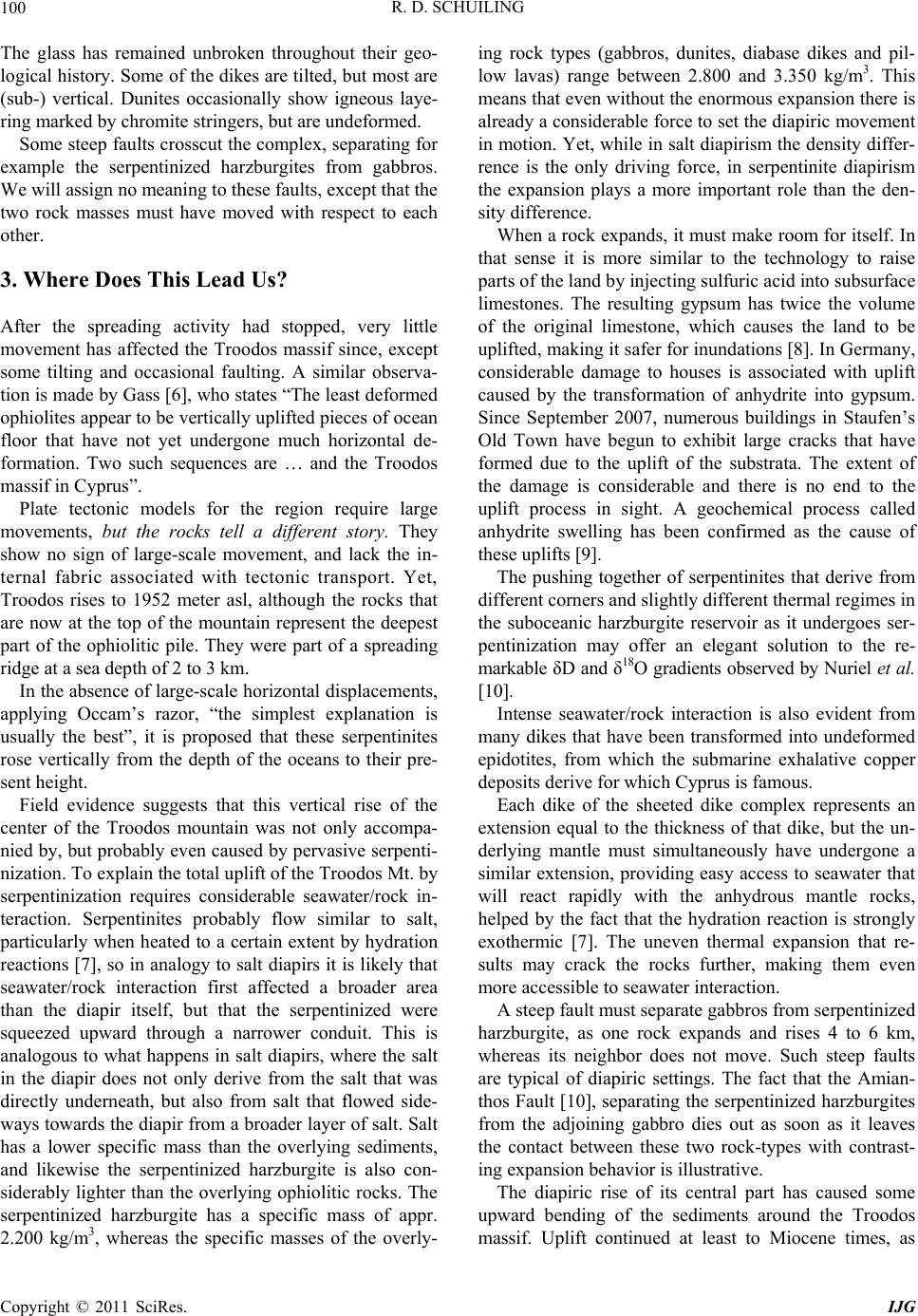
R. D. SCHUILING
Copyright © 2011 SciRes. IJG
100
The glass has remained unbroken throughout their geo-
logical history. Some of the dikes are tilted, but most are
(sub-) vertical. Dunites occasionally show igneous laye-
ring marked by chromite stringers, but are undeformed.
Some steep faults crosscut the complex, separating for
example the serpentinized harzburgites from gabbros.
We will assign no meaning to these faults, except that the
two rock masses must have moved with respect to each
other.
3. Where Does This Lead Us?
After the spreading activity had stopped, very little
movement has affected the Troodos massif since, except
some tilting and occasional faulting. A similar observa-
tion is made by Gass [6], who states “The least deformed
ophiolites appear to be vertically uplifted pieces of ocean
floor that have not yet undergone much horizontal de-
formation. Two such sequences are … and the Troodos
massif in Cyprus”. .
Plate tectonic models for the region require large
movements, but the rocks tell a different story. They
show no sign of large-scale movement, and lack the in-
ternal fabric associated with tectonic transport. Yet,
Troodos rises to 1952 meter asl, although the rocks that
are now at the top of the mountain represent the deepest
part of the ophiolitic pile. They were part of a spreading
ridge at a sea depth of 2 to 3 km.
In the absence of large-scale horizontal displacements,
applying Occam’s razor, “the simplest explanation is
usually the best”, it is proposed that these serpentinites
rose vertically from the depth of the oceans to their pre-
sent height.
Field evidence suggests that this vertical rise of the
center of the Troodos mountain was not only accompa-
nied by, but probably even caused by pervasive serpenti-
nization. To explain the total uplift of the Troodos Mt. by
serpentinization requires considerable seawater/rock in-
teraction. Serpentinites probably flow similar to salt,
particularly when heated to a certain extent by hydration
reactions [7], so in analogy to salt diapirs it is likely that
seawater/rock interaction first affected a broader area
than the diapir itself, but that the serpentinized were
squeezed upward through a narrower conduit. This is
analogous to what happens in salt diapirs, where the salt
in the diapir does not only derive from the salt that was
directly underneath, but also from salt that flowed side-
ways towards the diapir from a broader layer of salt. Salt
has a lower specific mass than the overlying sediments,
and likewise the serpentinized harzburgite is also con-
siderably lighter than the overlying ophiolitic rocks. The
serpentinized harzburgite has a specific mass of appr.
2.200 kg/m3, whereas the specific masses of the overly-
ing rock types (gabbros, dunites, diabase dikes and pil-
low lavas) range between 2.800 and 3.350 kg/m3. This
means that even without the enormous expansion there is
already a considerable force to set the diapiric movement
in motion. Yet, while in salt diapirism the density differ-
rence is the only driving force, in serpentinite diapirism
the expansion plays a more important role than the den-
sity difference.
When a rock expands, it must make room for itself. In
that sense it is more similar to the technology to raise
parts of the land by injecting sulfuric acid into subsurface
limestones. The resulting gypsum has twice the volume
of the original limestone, which causes the land to be
uplifted, making it safer for inundations [8]. In Germany,
considerable damage to houses is associated with uplift
caused by the transformation of anhydrite into gypsum.
Since September 2007, numerous buildings in Staufen’s
Old Town have begun to exhibit large cracks that have
formed due to the uplift of the substrata. The extent of
the damage is considerable and there is no end to the
uplift process in sight. A geochemical process called
anhydrite swelling has been confirmed as the cause of
these uplifts [9].
The pushing together of serpentinites that derive from
different corners and slightly different thermal regimes in
the suboceanic harzburgite reservoir as it undergoes ser-
pentinization may offer an elegant solution to the re-
markable δD and δ18O gradients observed by Nuriel et al.
[10].
Intense seawater/rock interaction is also evident from
many dikes that have been transformed into undeformed
epidotites, from which the submarine exhalative copper
deposits derive for which Cyprus is famous.
Each dike of the sheeted dike complex represents an
extension equal to the thickness of that dike, but the un-
derlying mantle must simultaneously have undergone a
similar extension, providing easy access to seawater that
will react rapidly with the anhydrous mantle rocks,
helped by the fact that the hydration reaction is strongly
exothermic [7]. The uneven thermal expansion that re-
sults may crack the rocks further, making them even
more accessible to seawater interaction.
A steep fault must separate gabbros from serpentinized
harzburgite, as one rock expands and rises 4 to 6 km,
whereas its neighbor does not move. Such steep faults
are typical of diapiric settings. The fact that the Amian-
thos Fault [10], separating the serpentinized harzburgites
from the adjoining gabbro dies out as soon as it leaves
the contact between these two rock-types with contrast-
ing expansion behavior is illustrative.
The diapiric rise of its central part has caused some
upward bending of the sediments around the Troodos
massif. Uplift continued at least to Miocene times, as